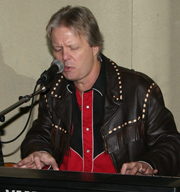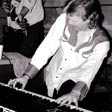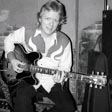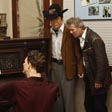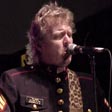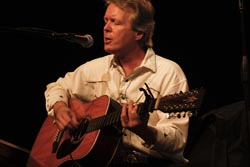Introduction to Delta Pieces: Northeast Louisiana Folklife
Map: Cultural Micro-Regions of the Delta, Northeast Louisiana

The Louisiana Delta: Land of Rivers








Ethnic Groups










Working in the Delta








Homemaking in the Delta




Worshiping in the Delta



Making Music in the Delta




Playing in the Delta







Telling Stories in the Delta



Delta Archival Materials
Bibliography

Kenny Bill Stinson
Ouachita Parish
Kenny Bill Stinson is a full-time musician who plays a range of roots music, but excels at rockabilly.
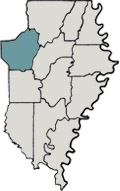
Performer and Songwriter Kenny Bill Stinson: "Mixing Country Music with the Blues"
By Susan Roach
Kenny Bill Stinson, a native of northeast Louisiana and a full-time musician, has been performing and working to preserve the music of this area for nearly forty years. Playing a range of roots music from blues to rock 'n' roll to country, Stinson excels at rockabilly. He was one of the featured Louisiana musicians in the River of Song CD and book. For some time he was said to be the state's best-kept musical secret, but now he has received recognition through his performances in state and national folklife festivals and his award of the Louisiana Division of the Arts 2004-05 Artist Fellowship in Folklife.
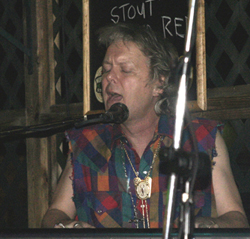
Stinson tried living in Nashville briefly and toured with the likes of Charlie Rich, Dale Hawkins, Rosanne Cash, and Rodney Crowell, and opened locally for Bob Dylan. However, he opted to stay in his beloved north Louisiana, where he lived on his place, the "Stinsonian" in the country near Downsville, until his recent move to nearby West Monroe. Making his living through his music, he continues to play the New Orleans Jazz and Heritage Festival (a favorite), area folk and commodity festivals, concerts, weddings, parties, and clubs. His club performances range from House of Blues in New Orleans to the local Enoch's Pub, the major roots music venue in Monroe, where he has been a regular for years. His performances vary depending on what the gig requires. He excels at early rockabilly, but he has also captivated audiences with an all Beatles performance, complete with his Sgt. Pepper uniform.
He also hosted a weekly radio music show, Blue Monday, on the Monroe public radio station KEDM, where he shared his encyclopedic musical knowledge.
His Musical Roots
The music he experienced growing up included old-time country, the blues, and gospel with a little bluegrass. Born in 1953 into a Church of Christ family, he learned to sing by ear at a young age through congregational singing in church. He says the four-part a cappella singing would "just wash over me" (Stinson 2012). His parents' had some musical talent: his father played a little boogie-woogie piano, and his mother had played saxophone in the school band. Without doubt, this vocal experience and his inherited family musical abilities provided him with the versatile vocal skills described by music writer and folklorist Ben Sandmel: "His baritone is warm and melodic, perfect for ballads or Beatle tunes, yet easily adaptable to the gruffest, grittiest blues and funk; . . .[it is] Southern in inflection, and underlined with emotional sincerity" (32). While the Church of Christ worship services did not permit instruments, some of the men from the church played musical instruments at home. Stinson liked to go hang out with them and listen to them play. Sandmel reports how Stinson discovered guitar when he was about ten and visiting a friend from church, Tom Burnett, who had an old guitar in his closet that he didn't know how to play. Stinson took it home and in a few days had "worked up a couple of Ventures tunes like 'Walk Don't Run' and 'Pipeline.'" Stinson began hanging out with Burnett and other men from the church, and they formed a band. Another friend from church, Don DeLukie, had a blues band and included Stinson (Sandmel 34). With the help of these church friends and the Mel Bay chord book, Stinson taught himself to play guitar. As his interest in music developed, he wanted to learn piano, so his family rented a piano for him. With no formal lessons, he proceeded to teach himself to play by ear and practiced daily. As he grew older, he was curious about the live music in the area's honky-tonks and barrooms. Stinson describes how his early experiences led to the kind of music he loves to play:
When I wasn't old enough to go inside these nightspots, I eventually started sneaking around to the back doors and meeting the musicians who worked there. They would always encourage me and would leave the door open so I could peep in and watch them play this great honky tonk blues music. The music I heard was always upbeat and full of anecdotes and humorous stories of the workingman and his struggles. The musicians themselves were always the coolest characters I've ever known, country hipsters, if you will, seemingly without a care for tomorrow. This was my learning ground and is where I formed a lot of my musical sensibilities in the North Louisiana tradition. Around this same time while I was still in high school, I attended a Jerry Lee Lewis concert at the Monroe Civic Center. As I was listening and watching him, I remember I thought to myself, "This is my kind of music, and this is what I would like my band to sound like." I knew from then on that I would be mixing country music with the blues to make my own concoction that most folklorists recognize as rockabilly. (Stinson 2004)
He describes rockabilly as "kind of like a train wreck of country music and the blues; they kind of crashed together and blew up" (Wald and Junkerman 258).
Instrumentalist and Songwriter
Equally good on piano and guitar, Stinson also plays bass, harmonica, and drums—all by ear—and writes songs as well. Going beyond traditional roots music, his song-writing influences run the gamut from rockabilly to country to Beatles and Eric Clapton-inspired rock 'n' roll. In the book accompanying the film and CD, The Mississippi: River of Song, Stinson says, "My music is all about having fun in life, and all the little stuff that I go through in this area.
It all builds up and then a song comes out—it might take six months or a year, but all of a sudden all these songs start coming into my mind and it seems to be it's all pretty true to what I'm living through" (Wald and Junkerman 261). His rockabilly song recorded on the River of Song CD, "Taters and Gravy and Chicken-Fried Steak," celebrates the north Louisiana food traditions, which he loves:
Yeah, I like my rice and gravy and my black-eyed peas,
Corn on the cob, I want a big glass of tea
Some okra and tomatoes and some turnip greens
I want some real soul food; do you know what I mean?
Well, I'm going on down to Ma and Pa's Café-Mercy!
I want some taters and gravy and chicken-fried steak.
At first he was uncertain about his songwriting, but as he recounts, he received encouragement from another area guitarist:
I've been writing songs for years, but never thought I had strong enough material until I made my first recording in the year 2000. I was totally blown away when one of my North Louisiana heroes told me that he would like to put some guitar on my record. This hero was none other than the man who had played on countless recordings from some of my favorite artists, such as Jerry Lee Lewis, Elvis Presley, Ricky Nelson, Gram Parsons, Roy Orbison and Merle Haggard: Shreveport's native son, James Burton. This gesture of passing the torch made me believe that James thought I was on the right track as far as the authenticity of my music and songwriting and helped me bolster my quest to play authentic North Louisiana rock-n-roll. (Stinson 2004)
With Burton's encouragement, Stinson went on to make his first CD, Inspiration (2001), providing almost all the instrumentation and vocals, with some help from Burton.
Stinson has fun with his lyrics and music, juxtaposing music from different eras, genres, and media in the same song. His mastery of a variety of styles could be seen as post modern, yet his music is indeed authentic. He finds inspiration for the songs on this album in the various musical traditions of the state and in his everyday life. For example, his song "Frozine," with its swamp pop sound, is based on the name of the wife of a Monroe barber Stinson admired because he and his wife provided a center distributing free clothing to the needy. Stinson thought north Louisiana needed a song like south Louisiana's "Matilda," and "Frozine" would be a great response. His early rockabilly-inspired song "Country Girl," echoes Jerry Lee Lewis on piano and references the theme from the 1960s television show Green Acres in its opening; its lyrics extol the virtues of a wife who maintains traditional roles:
She can wash all day and cook all night;
Get in the bed, everything's all right.
You go to the country, you'll see her in her old rocking chair.
She grows her garden; all her flowers look good.
She knows she's doing what she should.
She's a country girl, raised out on the farm.
She's a little country girl and won't do you no harm.
After his first CD, Stinson said he read a book on songwriting by songwriter Jimmy Webb, where he learned among other things that he needed a rhyming dictionary. Subsequently, he said he became a better writer. Stinson's CD, F- Earl (2007), took its title and cover art from a drawing by his son and features more of his own songs, including his rockabilly "All Goofed Up," showing, according to critic Alex Rawls, "a good-natured love of rock 'n' roll in all its traditional forms, and the great records [that] shaped Stinson's musical vocabulary."1
He continues to produce his own life-inspired songs. His Kickin' in My Stall CD (2009) includes a range of styles, from 1950s-style rock n' roll on his "Little Church in the Piney Woods," to his rockabilly "Contagious," to his instrumental echoes of Jimmy Buffett in his "Sunday Night in Shreveport," about a lonely musician in a Shreveport casino. Familiar with the casino circuit, Stinson captures the late night imagery such as the waitress eating wings at the bar and the beer bellies of the male clientele. Revealing Stinson's sensitive, darker side, his haunting "Rhinestones and Butterflies," written in a minor key about a musician going through a liminal time, references the loss of his own mother in the refrain: "Mama used to love Jim Reeves; she loved Patsy Cline." Stinson uses traditional ballad-style incremental repetition in the refrain of this long song to reveal more about the mother after each verse: "Mama loved Porter and Dolly;/ she loved Patsy Cline," "Mama used to roll her own/ listening to Patsy Cline," and "Mama used to make me pull switches/ when she'd whip my behind." The song's opening line placing a down-and-out musician locally, but tuned in globally mirrors the global musical experience which Stinson gave up because of his attachment to his local community: "Sitting in the kitchen, listening to the World Café/ I'd really like to write some songs/ but I ain't got nothing to say/ I fired all my friends, and then I fired my wife and my band/ Now it's just me and my dogs, Howling Wolf, and raising sand." The deep, lonesome feeling this song provokes with its motifs of loss of mother, wife, and friends reflects Stinson's roots in the South and the sad country music of Hank Williams and the blues.
While his recordings tend to be solo productions with Stinson playing all the instruments and singing all the vocals, he is equally impressive in solo live performances playing either acoustic 12-string guitar or electric guitar or his Yamaha keyboard. For instance, in his solo performance at the Delta Music Museum in Ferriday, the home of his idol Jerry Lee Lewis, he not only played both Lewis's and his own songs on keyboard, but also a mainly blues set on the 12-string, including two Leadbelly songs, "Pig Meat" and "Good Night, Irene."
While he graciously will play solo gigs, in his dynamic live performances he prefers to play with a band which he puts together. Adept at improvisation, he is also at home jamming with a bar band or even with an old-time fiddler or discussing his work for an artist-in-the-schools program. For the Southern Crossroads Festival at the 1996 Olympics in Atlanta, he organized the Ark-La-Mystics band and reprised it at the Smithsonian Festival of American Folklife in Washington on the National Mall in 1997.
He was the lead musician and vocals for the band, which included Maggie Warwick, a country musician from the Shreveport Louisiana Hayride era. A Washington Post music critic who heard Stinson with the band at the Washington Festival praised him: "He can do Jerry Lee Lewis better than Jerry Lee Lewis. . . . When he closes with 'Great Balls of Fire,' Mama, look out. He can make his electric keyboard stand on its tail" (Hendrickson B10).
Stinson has chosen a performing career, not a recording career; otherwise, he would have stayed in Nashville. His live performances are intense, deeply felt, and emotion-driven. He always gives 100%, regardless of the venue or the size of the audience. Obviously, he enjoys performing his different styles of music in live gigs, whether solo with his guitar and keyboard, with his Ark-La-Mystics band or with a bar band he has put together: "It's real good-feeling music; it makes me feel good, so I'm hoping it makes other people feel good, too. . . I have seen this music get hundreds of folks up out of their chairs and on to the dance floor to literally shake their troubles away."
Notes
1. For videos of Stinson performing "Taters and Gravy" and "All Goofed Up," search YouTube.
Works Cited
Hendrickson, Paul. "Folklife's Fertile Ground: Delta Traditions Blossom at Festival on the Mall." Washington Post. 3 July 1997: B1+. Print.
Rawls, Alex. "Kenny Bill Stinson: Kickin' in My Stall (Independent)". Rev. Offbeat. 01 August 2009. Web. http://www.offbeat.com/2009/08/01/kenny-bill-stinson-kickin-in-my-stall-independent/
---. "Kenny Bill Stinson, F- Earl. (Independent). Offbeat. 01 March 2007. Web. http://www.offbeat.com/2007/03/01/kenny-bill-stinson-f-earl-independent/
Sandmel, Ben. "The Roots of Kenny Bill Stinson." Louisiana Life. Nov./Dec.1987: 32, 34. Print.
---. "Sound Advice: A Bountiful Backlog." Louisiana Cultural Vistas. Summer, 2001: 94-95. Print.
Stinson, Kenny Bill. Personal Interview. 27 February 2004.
---. Narrative Stage Presentation, Natchitoches Folk Festival, 21 July 2012.
Wald, Elijah and John Junkerman. "North Louisiana Twang: Kenny Bill Stinson." In The Mississippi: River of Song. New York: St. Martin's Press, 1999. 258-261. Print.
Discography
Stinson, Kenny Bill. F- Earl. Independent. 2007. CD.
---. Inspiration, Soigne Recordings, 2001. CD.
---. Kicking in My Stall, (Independent), 2009. CD.
"Taters and Gravy and Chicken Fried Steak." The Mississippi: River of Song, Smithsonian Folkways Recordings: SFW 40086, 1998. CD.



